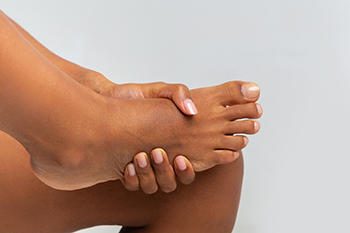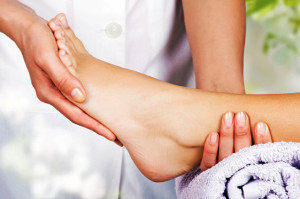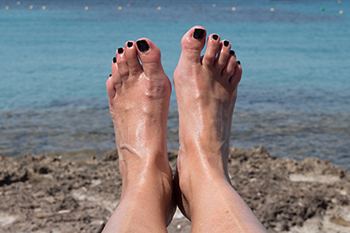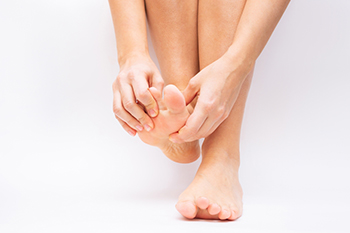Connect With Us
Blog
Items filtered by date: August 2022
Causes of Tarsal Tunnel Syndrome

The medical term for the foot condition known as tarsal tunnel syndrome is posterior tibial neuralgia. It can cause severe pain and discomfort as a result of a compressed tibial nerve as it travels through the tarsal tunnel. Patients who experience this ailment may have a predisposition to diabetes, alcoholism, or specific types of neuropathies. The symptoms that are often associated with tarsal tunnel syndrome consist of tenderness surrounding the ankle, a lack of feeling in the sole, and difficulty walking or standing. It may be a frequent ailment among people who have flat feet, and the fallen arch may begin to compress the nerve. Additionally, if a foot injury has occurred, it may damage the tarsal tunnel and the nerve that is inside it. If you have any of the above symptoms, it is suggested that you have a physical examination from a podiatrist who can accurately diagnose and treat this condition.
Tarsal tunnel syndrome can be very uncomfortable to live with. If you are experiencing tarsal tunnel syndrome, contact the foot specialists of Affiliates in Foot Care, P.C.. Our doctors can provide the care you need to keep you pain-free and on your feet.
Tarsal Tunnel Syndrome
Tarsal tunnel syndrome, which can also be called tibial nerve dysfunction, is an uncommon condition of misfiring peripheral nerves in the foot. The tibial nerve is the peripheral nerve in the leg responsible for sensation and movement of the foot and calf muscles. In tarsal tunnel syndrome, the tibial nerve is damaged, causing problems with movement and feeling in the foot of the affected leg.
Common Cause of Tarsal Tunnel Syndrome
- Involves pressure or an injury, direct pressure on the tibial nerve for an extended period of time, sometimes caused by other body structures close by or near the knee.
- Diseases that damage nerves, including diabetes, may cause tarsal tunnel syndrome.
- At times, tarsal tunnel syndrome can appear without an obvious cause in some cases.
The Effects of Tarsal Tunnel Syndrome
- Different sensations, an afflicted person may experience pain, tingling, burning or other unusual sensations in the foot of the affected leg.
- The foot muscles, toes and ankle become weaker, and curling your toes or flexing your foot can become difficult.
- If condition worsens, infections and ulcers may develop on the foot that is experiencing the syndrome.
A physical exam of the leg can help identify the presence of tarsal tunnel syndrome. Medical tests, such as a nerve biopsy, are also used to diagnose the condition. Patients may receive physical therapy and prescriptive medication. In extreme cases, some may require surgery.
If you have any questions please feel free to contact our office located in Woburn, MA . We offer the newest diagnostic and treatment technologies for all your foot and ankle needs.
Two Types of Foot Therapy

Foot massages are a common form of relaxation, and many people choose this type of foot therapy to find relief from aching feet. It may come from standing all day or from wearing shoes that do not fit correctly. An additional method of therapy is reflexology and there are differences between the two. Reflexology is practiced by applying pressure to specific areas of the foot which can stimulate the central nervous system and can positively affect energy pathways. Different organs in the body are linked to pressure points on the feet and may have healing effects. Getting a foot massage involves massaging the entire foot without centering on certain areas. Some of the health benefits from either form of foot therapy can consist of improved circulation, relaxation, stress relief, and reduced muscle tension. Some patients find relief from headaches and back pain and can enjoy an overall sense of well-being. If you are interested in learning more about the benefits of different types of foot therapy, it is suggested that you consult with a podiatrist who can answer any questions you may have.
Foot therapy is often necessary for those recovering from either foot deformities or foot injuries. If you have concerns regarding therapy, consult with the foot specialists from Affiliates in Foot Care, P.C.. Our doctors can provide the care you need to keep you pain-free and on your feet.
Most Common Injuries
People who are active or athletes are prone to a variety of injuries. Therefore, it is often important to take part in physical therapy in order to quickly get back on the right track.
What to Do When Injured
Physical Therapy – This specialized treatment will focus on the affected area, speeding up recovery and the overall healing process. It is a proven method that has helped millions of people return from any injury.
During physical therapy you will undergo regimented training to get back into full form. Training is often very difficult, especially at first when the foot feels weak. Physical therapy often involves:
Basic stretching and twisting exercises – getting the feet’s mobility and flexibility up.
Massaging – the therapist will massage the injured area in order to activate the muscles and relax them.
Strengthening Exercises – this allows the muscles in the affected area to regain their full strength, a vital step towards full recovery.
If you have any questions please feel free to contact our office located in Woburn, MA . We offer the newest diagnostic tools and technology to treat your foot and ankle needs.
Is Podiatry a Good Career Choice for Me?

The type of doctor who specializes in foot conditions is referred to as a podiatrist. This type of doctor can diagnose and treat medical disorders of the foot and ankle. Research has indicated that podiatry dates back to ancient Egypt, and a scalpel was used to remove corns and calluses. Currently, a podiatrist will perform a physical exam in addition to listening to patients about specific foot concerns. Some of the conditions that podiatrists treat include bunions, hammertoe, and ingrown toenails. Surgery may be necessary to treat the removal of bone spurs, cysts, and tumors. Additionally, they are able to prescribe custom-made orthotics that may help to improve mobility and balance. There are doctors who choose to specialize in a specific branch of podiatry. These can consist of pediatric, sports, and advanced surgery which can rebuild the foot and ankle after an injury. Many podiatrists prefer to work in a hospital setting, general practice, or health maintenance organizations. If you think this is a positive career choice for you, please consult with a podiatrist who can help you with your decision.
If you are experiencing pain in the feet or ankles, don’t join the stubborn majority refusing treatment. Feel free to contact the foot specialists from Affiliates in Foot Care, P.C.. Our doctors can provide the care you need to keep you pain-free and on your feet.
What Is a Podiatrist?
Someone would seek the care of a podiatrist if they have suffered a foot injury or have common foot ailments such as heal spurs, bunions, arch problems, deformities, ingrown toenails, corns, foot and ankle problems, etc.
Podiatric Treatment
A podiatrist will treat the problematic areas of the feet, ankle or lower leg by prescribing the following:
- Physical therapy
- Drugs
- Orthotic inserts or soles
- Surgery on lower extremity fractures
A common podiatric procedure a podiatrist will use is a scanner or force plate which will allow the podiatrist to know the designs of orthotics. Patients are then told to follow a series of tasks to complete the treatment. The computer will scan the foot a see which areas show weight distribution and pressure points. The podiatrist will read the analysis and then determine which treatment plans are available.
If you have any questions please feel free to contact our office located in Woburn, MA . We offer the newest diagnostic and treatment technologies for all your foot and ankle needs.
Using a Pumice Stone

Although a podiatrist can help you maintain the health of your feet, there are many things that you can do every day to practice proper foot health. For example, people other than those with diabetes might consider incorporating a pumice stone into their foot care routine. However, it is important to know exactly how a pumice stone should and should not be used. Pumice stones can be used on the feet to target and remove dry or dead skin. Most commonly, individuals might use a pumice stone to remove dead skin on the heels and around the toes. To use a pumice stone, soak the feet in warm, soapy water for 10 to 15 minutes. Also be sure to soak the stone, as you do not want to apply a dry stone to the skin. Apply the stone to the target area, using small circular motions, gently applying a small amount of pressure. Importantly, if you apply too much pressure, you might remove too much skin. After application, rinse your skin and the pumice stone then pat your feet dry. You might even finish up the routine by applying a moisturizer to the feet. Contact a podiatrist to see if adding a pumice stone into your daily foot care routine is right for you.
Everyday foot care is very important to prevent infection and other foot ailments. If you need your feet checked, contact the foot specialists from Affiliates in Foot Care, P.C.. Our doctors can provide the care you need to keep you pain-free and on your feet.
Everyday Foot Care
Often, people take care of their bodies, face and hair more so than they do for their feet. But the feet are a very important aspect of our bodies, and one that we should pay more attention to. Without our feet, we would not be able to perform most daily tasks.
It is best to check your feet regularly to make sure there are no new bruises or cuts that you may not have noticed before. For dry feet, moisturizer can easily be a remedy and can be applied as often as necessary to the affected areas. Wearing shoes that fit well can also help you maintain good foot health, as well as making it easier to walk and do daily activities without the stress or pain of ill-fitting shoes, high heels, or even flip flops. Wearing clean socks with closed shoes is important to ensure that sweat and bacteria do not accumulate within the shoe. Clean socks help to prevent Athlete’s foot, fungi problems, bad odors, and can absorb sweat.
If you have any questions please feel free to contact our office located in Woburn, MA . We offer the newest diagnostic and treatment technologies for all your foot and ankle needs.
Are Bunions Affecting Your Everyday Life?
Gout or a Bunion May Cause Toe Pain

The big toe plays a significant role in helping to stay balanced as daily activities are completed. There are several reasons why pain in the big toe can occur, including gout, a bunion, bone tumor, or if a toe injury has occurred. It is important to obtain a proper diagnosis that can determine the cause of the pain which will precede beginning the correct treatment. The diagnosis process may consist of having an X-ray taken, or having a CAT scan or MRI performed. When pain is present in the big toe, larger shoes are often needed to make the foot feel more comfortable. For pain that is moderate or severe, the patient may benefit by performing specific stretches that may help to ease the pain. Additionally, it may help to implement a healthy eating regime, drink plenty of water daily, and participate in physical therapy if needed. If you have toe pain, it is advised that you have a consultation with a podiatrist who can determine the cause and offer the best treatment plan for you.
Toe pain can disrupt your daily activities. If you have any concerns, contact the foot specialists of Affiliates in Foot Care, P.C.. Our doctors can provide the care you need to keep you pain-free and on your feet.
What Causes Toe Pain?
Most severe toe pain is caused due to a sports injury, trauma from dropping something heavy on the toe, or bumping into something rigid. Other problems can develop over time for various reasons.
Toe pain can be caused by one or more ailments. The most common include:
- Trauma
- Sports injury
- Wearing shoes that are too tight
- Arthritis
- Gout
- Corns and calluses
- Hammertoe
- Bunions
- Blisters
- Ingrown toenails
- Sprains
- Fractures (broken bones)
- Dislocations
When to See a Podiatrist
- Severe pain
- Persistent pain that lasts more than a week
- Signs of infection
- Continued swelling
- Pain that prevents walking
Diagnosis
In many cases the cause of toe pain is obvious, but in others, a podiatrist may want to use more advanced methods to determine the problem. These can range from simple visual inspections and sensation tests to X-rays and MRI scans. Prior medical history, family medical history, and any recent physical traumatic events will all be taken into consideration for a proper diagnosis.
Treatment
Treatments for toe pain and injuries vary and may include shoe inserts, padding, taping, medicines, injections, and in some cases, surgery. If you believe that you have broken a toe, please see a podiatrist as soon as possible.
If you have any questions please feel free to contact our office located in Woburn, MA . We offer the newest diagnostic tools and technology to treat your foot and ankle needs.

